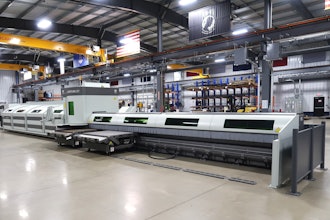Economic activity in the manufacturing sector expanded in April for the second consecutive month, while the overall economy grew for the 83rd consecutive month, say the nation’s supply executives in the latest Manufacturing ISM Report On Business.
Manufacturing expanded in April as the PMI registered 50.8 percent, a decrease of 1 percentage point from the March reading of 51.8 percent, indicating growth in manufacturing for the second consecutive month, following five consecutive months of contraction in manufacturing. A reading above 50 percent indicates that the manufacturing economy is generally expanding; below 50 percent indicates that it is generally contracting.
Bradley J. Holcomb, CPSM, CPSD, chair of the Institute for Supply Management Manufacturing Business Survey Committee states, “The past relationship between the PMI and the overall economy indicates that the average PMI® for January through April (50.1 percent) corresponds to a 2.2 percent increase in real gross domestic product (GDP) on an annualized basis. In addition, if the PMI for April (50.8 percent) is annualized, it corresponds to a 2.4 percent increase in real GDP annually.”
A PMI above 43.2 percent, over a period of time, generally indicates an expansion of the overall economy. Therefore, the April PMI indicates growth for the 83rd consecutive month in the overall economy, while indicating growth in the manufacturing sector for the second consecutive month.
Orders, Production and Inventory
ISM’s New Orders Index registered 55.8 percent in April, which is a decrease of 2.5 percentage points when compared to the 58.3 percent reported for March, indicating growth in new orders for the fourth consecutive month. A New Orders Index above 52.2 percent, over time, is generally consistent with an increase in the Census Bureau’s series on manufacturing orders (in constant 2000 dollars).
ISM’s Production Index registered 54.2 percent in April, which is a decrease of 1.1 percentage points when compared to the 55.3 percent reported for March, indicating growth in production in April for the fourth consecutive month. An index above 51.3 percent, over time, is generally consistent with an increase in the Federal Reserve Board’s Industrial Production figures.
The Inventories Index registered 45.5 percent in April, which is a decrease of 1.5 percentage points when compared to the 47 percent reported for March, indicating raw materials inventories are contracting in April for the 10th consecutive month at a faster rate than in March. An Inventories Index greater than 42.8 percent, over time, is generally consistent with expansion in the Bureau of Economic Analysis (BEA) figures on overall manufacturing inventories (in chained 2000 dollars).
ISM’s Backlog of Orders Index registered 50.5 percent in April, a decrease of 0.5 percentage point as compared to the March reading of 51 percent, indicating growth in order backlogs for the second consecutive month. Of the 87 percent of respondents who reported their backlog of orders, 24 percent reported greater backlogs, 23 percent reported smaller backlogs, and 53 percent reported no change from March.
Exports, Imports and Prices
ISM’s New Export Orders Index registered 52.5 percent in April, which is an increase of 0.5 percentage point when compared to the March reading of 52 percent. This month’s reading indicates growth in new export orders for the second consecutive month.
ISM’s Imports Index registered 50 percent in April, which is 0.5 percentage point higher than the 49.5 percent reported in March, indicating that imports in April are unchanged from March.
The ISM Prices Index registered 59 percent in April, which is an increase of 7.5 percentage points when compared to the 51.5 percent reported for March, indicating an increase in raw materials for the second consecutive month and only the second time since October 2014. In April, 28 percent of respondents reported paying higher prices, 10 percent reported paying lower prices, and 62 percent of supply executives reported paying the same prices as in March. A Prices Index above 52.4 percent, over time, is generally consistent with an increase in the Bureau of Labor Statistics (BLS) Producer Price Index for Intermediate Materials.
Employment
ISM’s Employment Index registered 49.2 percent in April, which is an increase of 1.1 percentage points when compared to the 48.1 percent reported for March, indicating contraction in employment for the fifth consecutive month, but at a slower rate of contraction than in March. An Employment Index above 50.6 percent, over time, is generally consistent with an increase in the Bureau of Labor Statistics (BLS) data on manufacturing employment.
The monthly Manufacturing ISM Report on Business is based on the survey results of approximately 350 professionals across 18 different industry sectors. The report is released on the first business day of each month and features the PMI Index as its key measure. For more information on the Institute for Supply Management, visit www.ism.ws.






















